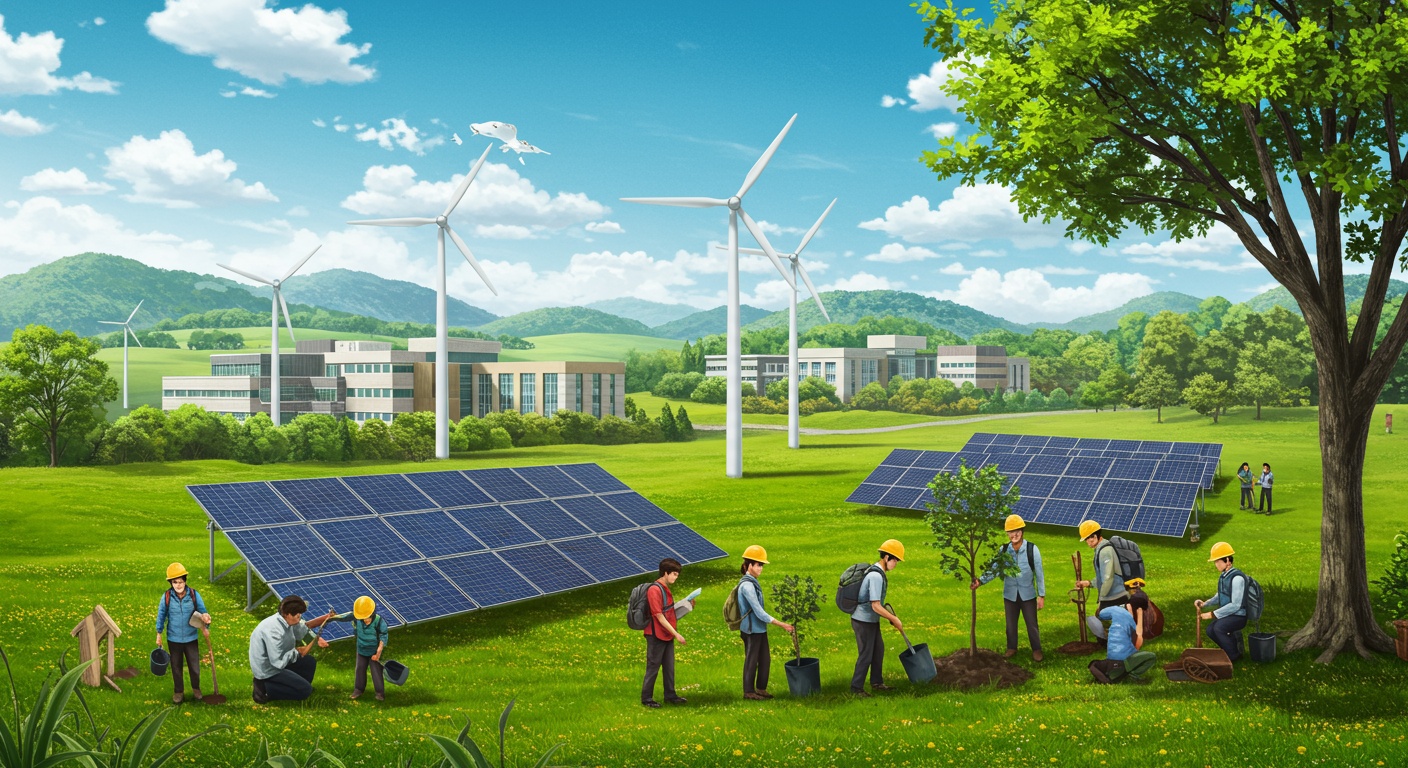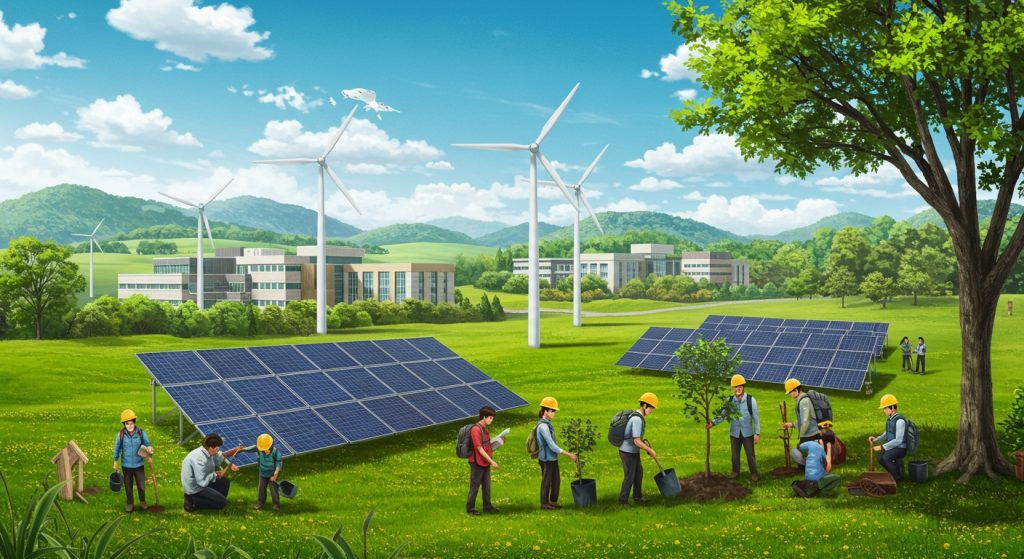Universities, traditionally ivory towers of knowledge, are rapidly transforming into proving grounds for planetary stewardship. Spurred by student activism and escalating climate concerns, campuses are pioneering innovative sustainability initiatives. Beyond installing solar panels, institutions are embracing circular economy principles, exemplified by the University of California system aiming for zero waste by 2025. Forward-thinking energy management systems, like those at Arizona State University which optimize building performance based on real-time occupancy, showcase the potential of smart technology. As pressure mounts for tangible carbon reductions, universities are uniquely positioned to lead by example, fostering a generation equipped to tackle global environmental challenges and shaping a more sustainable future through research, policy. Practice.

The Rise of the Green Campus: A Global Movement
Universities are no longer just centers of learning; they are becoming vital hubs for environmental stewardship. The “green campus” movement is a global phenomenon, with institutions worldwide embracing sustainable practices to minimize their environmental footprint. This isn’t just about recycling bins and energy-efficient light bulbs; it’s a comprehensive shift in mindset, encompassing everything from curriculum design to campus infrastructure.
What Makes a Campus “Green”? Key Pillars of Sustainability
A truly green campus operates on several key pillars of sustainability. These pillars guide the university’s efforts and ensure a holistic approach to environmental responsibility. Here’s a breakdown:
- Energy Efficiency: Reducing energy consumption through efficient building design, renewable energy sources (solar, wind). Smart grid technologies.
- Water Conservation: Implementing water-saving fixtures, rainwater harvesting systems. Drought-resistant landscaping.
- Waste Reduction and Recycling: Promoting waste minimization, comprehensive recycling programs. Composting initiatives.
- Sustainable Transportation: Encouraging walking, biking. Public transportation through bike-sharing programs, shuttle services. Carpool incentives.
- Green Building Design and Construction: Utilizing sustainable building materials, optimizing energy performance. Minimizing environmental impact during construction and renovation.
- Sustainable Food Systems: Sourcing local and organic food, reducing food waste. Promoting plant-based meal options.
- Curriculum and Research: Integrating sustainability into academic programs and conducting research on environmental issues and solutions.
- Community Engagement: Partnering with local communities to promote sustainability initiatives and raise environmental awareness.
Energy Efficiency: Powering the Campus of the Future
Energy consumption is a significant contributor to a university’s carbon footprint. Green campuses are tackling this issue head-on through various strategies.
- LED Lighting Conversion: Replacing traditional lighting with LEDs can drastically reduce energy consumption. LEDs are far more efficient and have a longer lifespan.
- Smart Building Management Systems: These systems use sensors and automation to optimize energy use in buildings. They can adjust lighting, heating. Cooling based on occupancy and weather conditions.
- Renewable Energy Integration: Many universities are installing solar panels on rooftops or investing in wind energy to generate their own clean electricity.
- Geothermal Energy: Utilizing the earth’s constant underground temperature to heat and cool buildings can lead to significant energy savings.
For example, Arizona State University (ASU) has made significant strides in renewable energy. They have installed numerous solar panel arrays across their campuses, generating a substantial portion of their electricity needs from solar power. This has not only reduced their carbon emissions but also saved them money on energy costs.
Water Conservation: Precious Resource Management
Water scarcity is a growing concern. Universities are playing a crucial role in conserving this vital resource. Here’s how:
- Low-Flow Fixtures: Installing low-flow toilets, faucets. Showerheads can significantly reduce water consumption in restrooms and dormitories.
- Rainwater Harvesting: Collecting rainwater and using it for irrigation or non-potable purposes like flushing toilets can conserve significant amounts of freshwater.
- Drought-Resistant Landscaping: Replacing traditional lawns with native plants that require less water can minimize the need for irrigation.
- Smart Irrigation Systems: These systems use sensors to monitor soil moisture and adjust irrigation schedules accordingly, preventing overwatering.
The University of California, Irvine (UCI) is a prime example of water conservation efforts. They have implemented extensive water-saving measures, including drought-resistant landscaping and a reclaimed water system that provides water for irrigation and cooling towers.
Waste Reduction and Recycling: Closing the Loop
Reducing waste and increasing recycling rates are essential components of a green campus. This involves a multi-pronged approach:
- Comprehensive Recycling Programs: Providing convenient and clearly labeled recycling bins throughout campus and educating students, faculty. Staff about proper recycling practices.
- Composting Initiatives: Collecting food waste and yard waste for composting, which can then be used to enrich soil in campus gardens.
- Waste Minimization Strategies: Encouraging the use of reusable containers, reducing paper consumption. Implementing policies to minimize waste generation.
- E-Waste Recycling: Establishing programs to properly dispose of electronic waste, ensuring that hazardous materials are recycled safely.
Yale University has a robust recycling program that includes single-stream recycling and composting. They also actively promote waste reduction through initiatives like reusable mug campaigns and paperless communication.
Sustainable Transportation: Moving Towards Greener Mobility
Transportation is another significant contributor to a university’s carbon footprint. Green campuses are promoting sustainable transportation options to reduce reliance on personal vehicles:
- Bike-Sharing Programs: Providing bicycles for students, faculty. Staff to use for short trips around campus.
- Shuttle Services: Offering shuttle services that connect different parts of campus and nearby communities.
- Carpool Incentives: Encouraging carpooling through preferential parking or discounted parking fees.
- Electric Vehicle Charging Stations: Installing charging stations for electric vehicles to support the adoption of zero-emission transportation.
- Improved Pedestrian and Bicycle Infrastructure: Creating safe and accessible pathways for walking and biking.
Stanford University is known for its comprehensive sustainable transportation program. They offer a free shuttle service, a bike-sharing program. Incentives for carpooling and using public transportation.
Green Building Design and Construction: Building for a Sustainable Future
New construction and renovation projects offer an opportunity to incorporate sustainable design principles and materials. Green building practices aim to minimize environmental impact throughout the building’s lifecycle:
- LEED Certification: Following the Leadership in Energy and Environmental Design (LEED) rating system, which provides a framework for designing, constructing, operating. Maintaining green buildings.
- Sustainable Building Materials: Using recycled content materials, locally sourced materials. Renewable materials like bamboo and reclaimed wood.
- Energy-Efficient Design: Optimizing building orientation, insulation. Window placement to minimize energy consumption.
- Water-Efficient Landscaping: Implementing xeriscaping principles to reduce water usage for landscaping.
Oberlin College’s Adam Joseph Lewis Center for Environmental Studies is a renowned example of green building design. It is a net-positive energy building, meaning it generates more energy than it consumes. It also features a living machine that treats wastewater on-site.
Sustainable Food Systems: Cultivating a Healthier Planet
The food we eat has a significant impact on the environment. Green campuses are promoting sustainable food systems by:
- Sourcing Local and Organic Food: Partnering with local farmers and suppliers to provide fresh, seasonal. Organic food in campus dining halls.
- Reducing Food Waste: Implementing strategies to minimize food waste in dining halls, such as trayless dining and food waste composting.
- Promoting Plant-Based Meal Options: Offering a variety of vegetarian and vegan options to reduce the environmental impact of meat production.
- Campus Gardens: Establishing campus gardens where students can grow their own food and learn about sustainable agriculture.
Middlebury College has a comprehensive sustainable food program that includes a student-run organic farm, a composting program. A commitment to sourcing local and sustainable food.
Curriculum and Research: Educating and Innovating for a Sustainable Future
Integrating sustainability into academic programs and conducting research on environmental issues are crucial for creating a more sustainable future. Universities are doing this by:
- Offering Sustainability-Focused Courses and Programs: Providing students with the knowledge and skills they need to address environmental challenges.
- Conducting Research on Renewable Energy, Climate Change. Other Environmental Issues: Contributing to the development of innovative solutions to environmental problems.
- Integrating Sustainability into Existing Courses: Incorporating sustainability concepts into courses across various disciplines.
- Supporting Student-Led Sustainability Initiatives: Encouraging students to develop and implement their own sustainability projects.
The University of Michigan’s School for Environment and Sustainability offers a wide range of academic programs focused on environmental issues. They also conduct cutting-edge research on climate change, renewable energy. Other sustainability topics.
Community Engagement: Partnering for a Greener World
Green campuses recognize that sustainability is a shared responsibility. They are actively engaging with local communities to promote sustainability initiatives and raise environmental awareness by:
- Partnering with Local Organizations: Collaborating with non-profits, businesses. Government agencies to address environmental challenges in the community.
- Offering Community Education Programs: Providing workshops, seminars. Other educational opportunities for community members on sustainability topics.
- Participating in Community Service Projects: Engaging students, faculty. Staff in volunteer projects that benefit the environment.
- Sharing Best Practices: Sharing their sustainability expertise and best practices with other institutions and organizations.
Portland State University has a strong commitment to community engagement. They partner with local organizations on a variety of sustainability initiatives, including urban gardening, waste reduction. Energy conservation.
The Role of Education and Finance in Driving Sustainability
Education plays a pivotal role in fostering a culture of sustainability. By integrating environmental topics into the curriculum, universities equip students with the knowledge and skills to become responsible global citizens. This includes understanding the financial implications of environmental decisions. For instance, students learn about the cost-effectiveness of renewable energy, the economic benefits of waste reduction. The financial risks associated with climate change.
Moreover, the Finance department plays a crucial role in implementing and supporting sustainability initiatives. Universities often allocate resources to fund green building projects, renewable energy installations. Waste management programs. They also explore innovative financing mechanisms, such as green bonds and revolving loan funds, to support sustainability projects. By aligning financial resources with environmental goals, universities demonstrate a commitment to long-term sustainability and inspire other institutions to follow suit.
Challenges and Opportunities: The Path Forward
While the green campus movement has made significant progress, there are still challenges to overcome. These include:
- Funding Constraints: Securing sufficient funding to implement sustainability initiatives.
- Resistance to Change: Overcoming resistance from stakeholders who may be hesitant to adopt new practices.
- Lack of Awareness: Raising awareness among students, faculty. Staff about the importance of sustainability.
- Measuring and Tracking Progress: Developing effective metrics to measure and track the progress of sustainability initiatives.
Despite these challenges, there are also significant opportunities for growth and innovation. These include:
- Leveraging Technology: Utilizing smart technologies to improve energy efficiency, water conservation. Waste management.
- Engaging Students: Empowering students to become leaders in sustainability.
- Collaborating with Other Institutions: Sharing best practices and collaborating on sustainability initiatives.
- Advocating for Policy Changes: Supporting policies that promote sustainability at the local, state. National levels.
Conclusion
University sustainability initiatives are no longer optional; they are vital to securing a healthier planet for future generations. We’ve seen how innovative approaches, from renewable energy adoption to waste reduction programs, are transforming campuses into models of environmental stewardship. But real change begins with individual action. Consider auditing your own consumption habits – perhaps committing to reusable containers or opting for cycling over driving, mirroring the growing trend of micro-mobility solutions on campuses like Amsterdam University College. My own journey started small, simply by composting food scraps. Now, I actively participate in my university’s green initiatives. We can all contribute, whether through advocating for sustainable policies or participating in campus clean-up drives. Remember, every small action amplifies when we act collectively. Let’s embrace the challenge, transforming our universities—and ourselves—into champions of sustainability. The time to act is now, for a brighter, greener tomorrow. For more on sustainable living see UNEP.
More Articles
Online Learning Revolution: The Future Of University Education Trends
Fair Admissions: Ethical Considerations In University Funding And Acceptance
Smart Money Moves: University Student Finance Tips And Tricks
Beyond Graduation: Exciting Career Paths with a Design Degree in the Future
FAQs
So, what’s the big deal with ‘green campuses’ anyway?
Think of it as universities trying to be eco-friendly rockstars! , it’s about reducing their environmental impact in every way possible, from saving energy and water to reducing waste and promoting sustainable practices. They’re trying to walk the talk when it comes to a healthier planet. You know, educating the next generation while they’re at it.
What kind of things do universities actually DO to be considered ‘green’?
Oh, a whole bunch! It could be anything from installing solar panels and using rainwater harvesting systems to offering courses on sustainability and running composting programs. Some even have green buildings certified by LEED (Leadership in Energy and Environmental Design). It’s all about finding creative ways to minimize their footprint.
Why should I care about my university going green? Does it really make a difference?
Absolutely! For starters, it can save the university (and eventually you, through tuition/fees) money by reducing energy and resource consumption. More importantly, it’s about creating a more sustainable future for everyone. Plus, you’ll be surrounded by people and ideas focused on positive change, which is pretty inspiring, right?
Okay. What if my university isn’t exactly a shining example of sustainability? What can I do?
Don’t despair! There are tons of ways to get involved. Start a sustainability club, push for more recycling bins, suggest green initiatives to your student government, or even just spread awareness among your friends. Every little bit helps. Student voices can be surprisingly powerful!
What are some cool, specific examples of universities doing sustainability really well?
There are many! Some universities are pioneering in renewable energy, generating much of their electricity on-site. Others have fantastic waste reduction programs that divert a huge percentage of waste from landfills. Still others excel at incorporating sustainability into their curriculum, so students from all disciplines learn about environmental issues.
Are there any downsides to ‘going green’ on campus? Like, does it cost a fortune?
While some initial investments are needed (like installing solar panels), many green initiatives actually save money in the long run through reduced utility bills and waste disposal costs. There might be some initial inconvenience as things change. The benefits for the environment and future generations outweigh those temporary hiccups.
So, how can I tell if my university is actually committed to sustainability, or just pretending?
Good question! Look for concrete actions, not just words. Check if they have a dedicated sustainability office, public reports on their environmental performance, or specific goals for reducing their carbon footprint. See if sustainability is integrated into the curriculum and research. And most importantly, talk to students and faculty involved in sustainability initiatives to get the inside scoop!



